In this article, we will discuss Embroidery Digitizing Glossary from A to Z. So, without wasting any time let’s dive deep into this informative article!

Ad copy is the lettering that is printed on an item; it could be the name, slogan, or trademark of an advertiser.

Appliqué is a decorative needlework in which pieces or patches of material in different shapes and designs are sewn or stuck onto a bigger piece to form a picture or design is called appliqué.

An arm machine is a multi-head embroidery machine that is driven by one major shaft. Each sewing head is connected to the shaft, usually by gears.

An automated color change follows a command of a multi-head commercial embroidery machine to change into another specific needle without interference.

The backing is when a woven or non-woven supporting fabric is added at the back of the fabric being embroidered. The backing can be hooped or placed between the throat plates. Backings come in 3 different weight types i.e. tear-away, cut-away, and wash-away.

Three stitches that are placed at the back & front between two points are named bean stitches. Bean stitch is used for outlining because it helps in removing the need for repeatedly digitizing a single-ply running stitch outline.

A collection of thread between goods and needle plates is called a birds nest. Its formation prevents the free movement of goods and can be caused by inadequate tensioning of the top thread or fading items.

A Blatt stitch is formed by closely arranged zigzag stitches laid down at any angle and with different stitch lengths.

A spool present inside the hook is called a bobbin. In an embroidery machine, the bobbins work similarly like on a home sewing machine.

A bobbin case is a small, cubical metal device that helps in holding the bobbin. It is also used in tensioning the bobbin thread and is placed in the hook for sewing.

Boring is an open work incorporated into embroidery designs and has a sharp edgy instrument that punctures the fabric. In boring, the stitches are made around the opening to enclose the rough edges.

A bridge machine is a head suspended on a bridge that goes across the machine. A bridge machine without the arm on the base is allowed to give a bigger sewing area from front to back on the embroidery machine. It is good for cutting pieces and for yarn goods also.

A woven material treated with a sticky substance to stabilize fabric for stitching is called buckram. Buckram is used for caps to hold the front panel in place.

In cap frames, specialized embroidery frames hold finished caps for embroidering. It is available in different styles for different machines, with two basic styles being to sew the finished cap flattened out, or sew the finished cap on a tubular machine in its natural curve.

Finished artwork of an embroidery design to be digitized

A chain stitch is a stitch that looks similar to a chain link and is formed with a single thread fed from the material’s bottom. A chain stitch is done manually or by a computerized machine with a hook that functions as a needle.

In upper thread tensioning check spring helps to detect upper thread breaks in a lot of embroidery machine models.
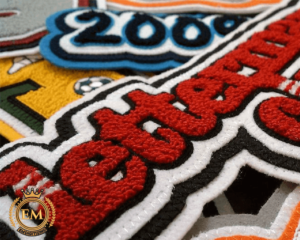
Chenille is an embroidery form in which a hoop stitch is formed on the fabric’s upper side. It uses heavy wool yarns, acrylic, or cotton.

Color fill is a combination of color and debossing.

A column stitch is a series of zigzag stitches that are closely placed to form a column. It is as well known as a satin stitch.

A digitizing capability that allows areas to be allocated as voids at the same time the edges of embroidery designs are defined is called complex fill. Hence, the embroidery design could be digitized as one fill area, regardless of being broken down into different sections.

The condensed format is a digitizing method to save embroidery designs in a skeletal form.

Conversion software reads information and converts it from one machine into another.
In customizing you can change aspects of embroidery designs via computerized editing programs. Most programs allow the user to scale designs up or down, edit stitch by stitch or block by the clock, merge lettering with the design, move objects of the design around, and other features.
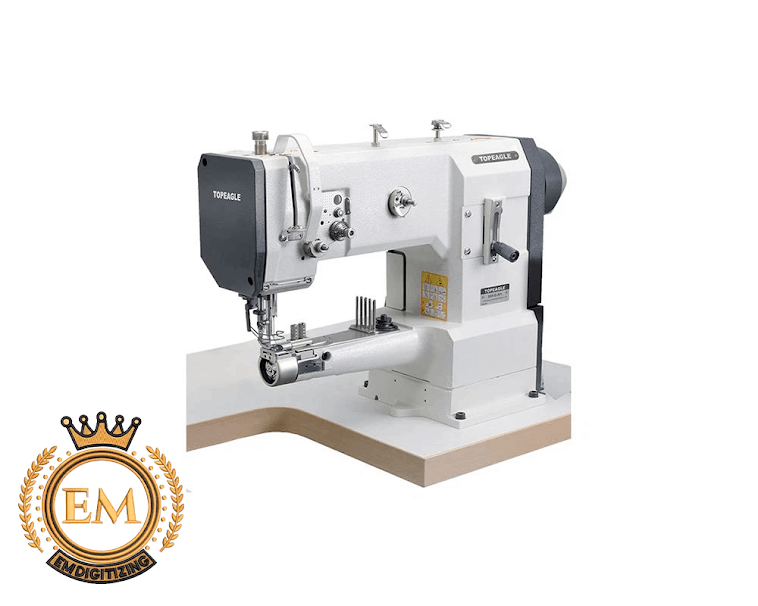
A cylinder arm machine is like a machine with cylinder beds. The hook assembly is housed in a cylinder-shaped arm, allowing items to curve around the cylinder for embroidery.
When the machine pressed a die into the surface of the fabric, resulting in a depressed print is called debossing.
A computer program that has a range of digitized designs kept by embroidery shops for embroiderers to access the design by stitch count, subjects, etc is called a design library.

Programming a design is called digitizing. Artwork is converted into a series of commands to be read by a computer.

A computer-aided design device used by digitizers to plot needle penetrations for embroidery designs is called digitizing tablet.
An internal or external device that is used to read the movements of the machine from a computer disk is called a disk reader.
Transferring a file from the net to your PC
In customizing you can change aspects of embroidery designs via computerized editing programs. Most programs allow the user to scale designs up or down, edit stitch by stitch or block by block, merge lettering with the pattern, move objects of the design around, and other features.
Embroidered design with a finished edge is commonly a sign of identification.
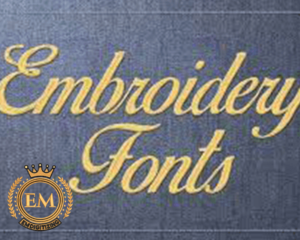
Unit of measurement in embroidery, in which ten points, is equal to one mm.
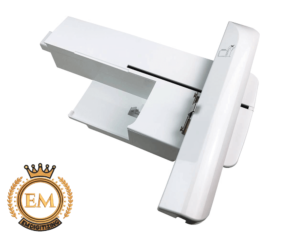
The part of the machine that holds and guides the hoop so you can embroider.
When stitches are in order and the design is specified to be in a particular size is called an expanded format.
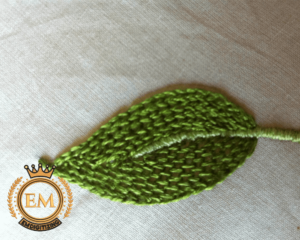
A fill stitch covers huge areas. Different fill designs could be made by changing the angle, and length, and repeating the sequence of the stitches. A fill stitch is also called a geflect stitch.
A few touches performed after embroidery is finished are called finishing. It includes trimming loose threads, cutting or tearing away extra backing, removing topping, cleaning any stains, etc.
The up-and-down motion of items under the embroidery head for the application of embroidery is called flagging.

Embroidery that is framed in hoops, generally exclusively on the top of the embroidery machine’s hook assembly.
You can define a complete font from a specific typeface like Times New Roman, Helvetica, Verdana, Arial, etc with a font.
Machine-specific readable information

The holding device for the insertion of items under an embroidery head for the embroidery application is called a frame.
Machine to help the framing process

The pantograph part to hold the frames is called a frame sash. It is as well called a sash.

A Series of running stitches commonly used to cover large areas is called geflect stitch.
Graphic imaging format; a type of picture fill
The physical parts of a computer are called hardware.

The hook holds the bobbin case in the embroidery machine and plays a major role in stitch formation.
The rotary device is designed to pass the needle at a given point in the needle bar rise. The hook point passes into a thread loop formed by the rising needle bar and pulls the thread around the bobbin case to form a lock stitch.
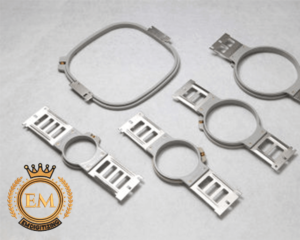
A device that is made up of plastic, steel, or wood with which material is held in place for machine embroidering is called a hoop (n).
Placing the material and/or stabilizer into the embroidery hoop is called hoop (v).
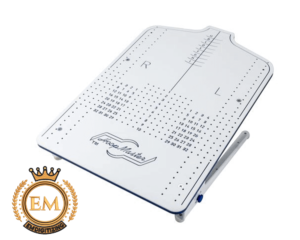
The board is intended to hold the outer part of the hoop while the goods to be embroidered are placed over the board to be hooped. Once the goods are placed right over the outer hoop, the operator places the inner portion of the hoop.

Hooping device is a device that helps in hooping clothing or goods for embroidery.
In typing, letterforms that slope to the right. For example italic

A rotary hook that holds a bobbin case with a lot larger thread capacity as compared to a standard hook is called a jumbo rotary hook.
In kern, you can add or delete spaces between pairs of adjacent characters.

Moving of frame without stitching but with a take-up lever and hook, movement is called jump stitch.

Lettering refers to the embroidery of letters, either made fully with stitches, or a mixture of cutout appliqué pieces or stitching.
A lock stitch also called a lockdown or tack-down stitch is formed by three or four consecutive stitches of about 10-point movement. It should be used at the end of all columns, fills, and at the end of any element in your design where jump stitches would follow, like color changes or the end of a design.
A machine that forms a stitch using a hook and needle:

A logo is the symbol, name, or trademark of an institution, organization, or company.

Loops on the surface of embroidery caused by bad top tension or tension problems are called looping. Generally happens when the polyester top thread has been improperly tensioned.
The formats and codes used by different machine owners within the embroidery business are called machine language.
Marking of goods to help in placing the frame and referencing the needle starting points
A machine system where a lot of separate stitching heads or head configurations are controlled by a central computer is called modular.

The embroidered design is composed of one or more than one letter, generally the initials in a name.

Moss stitch is an embroidery form in which a hoop stitch is formed on the upper side of the fabric. It uses heavy wool yarns, acrylic, or cotton.
A downy surface of fabric covering either a single side or both sides produced by brushing is called a nap.

A small piece of steel with a hole for thread and a point for stitching material is called a needle.

A needle plate is the metal plate placed above the hook assembly of an embroidery machine. It has a hole in the center through which the needle travels to reach the hook and form a stitch.
To link machines through a disk drive system and computer is called a network.

A minute cutting utensil with a spring action that is functioned by the thumb in a hole on the top blade and fingers cupped around the bottom blade is called a nipper.
The ability to move the pantograph out of the design with a particular movement and then return to the original point is called offset.
The starting point of your embroidery design is called the origin.
Specialties formed more than the number originally ordered
A bar, holder, or rack that frames or holding fixtures are connected to is called a pantograph.
A low-cost way of making a sample of an embroidery design is called pencil rub.
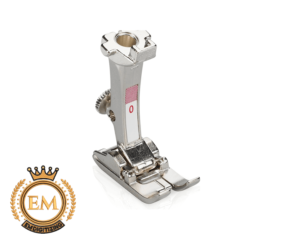
A presser foot is a metal device that touches the goods being embroidered while the needle is in the goods. Its key function is to hold the material being embroidered unless the hook point catches the thread loop produced by the needle rise.

Thread tension assemblies that are before the major tension assembly in the thread path are called pre-tensioner.

The outcome of the material being gathered by the stitches is called puckering.
A degree of distortion is made into a design by the digitizer to compensate for the pull on the fabric caused by the embroidery stitches.
This refers to the ability to line up details and parts of patterns with each other.
The layout is used for making decorations or patterns on a material span that is imitated at daily intervals.

One stitch that goes from point A to B is called a running stitch. It is often used for fine details, outlining, and underlay.
A type of style without cross strokes at the end of the major strokes is called sans-serif.
Any typeface with letters having cross strokes at the end of the major strokes is called serif type.

A series of zigzag stitches that are closely formed together is called a satin stitch.
The ability within one design program to expand or lessen an embroidery design is called scaling.
A device that takes a computer-readable picture and brings it into the computer memory so you can digitize the design with your software is called a scanner.
A digitizing method that places short stitches in curves and corners to prevent an unnecessary heavy buildup of stitches is called a short stitch.
Programs and/or files that the hardware uses to learn or perform different tasks are called software.
A fill stitch capability that makes a fill with a relief or motif design within the fill-stitch area is called specialty fill.
SPI – stitches per inch
SPM – stitches per minute
A digitizing feature that allows one or more stitches in a design to be changed or deleted is called stitch editing.
The measurement of stitch information using specialized software, allowing scaling of enlarged format designs with density compensation is called stitch processing.
Digitized embroidery designs that are commercially available for general use by embroiders.

Numbers or letters are cut from rayon or polyester twill fabric used commonly for athletic teams and institutions.
The tautness of thread when forming stitches is called tension.
A device used to adjust the thread tautness when forming stitches is called a tensioner.

A fine cord of natural or synthetic fabric made from more than two filaments coiled together and used for stitching is called a thread.
A minute cutting utensil with a spring action that is functioned by the thumb in a hole on the top blade and fingers cupped around the bottom blade is called a nipper.
Tagged image file format, is a type of graphics file.
Fabric hooped or placed on top of materials that have a definable nap or surface texture such as terry cloth and corduroy cloth before embroidery is called topping.

The action of cutting loose thread, removing the backing, etc, from the final embroidered project is called trimming.
Embroidery is produced on an embroidery machine which allows tubular material or pre-assembled clothing to be placed around the hook assembly.
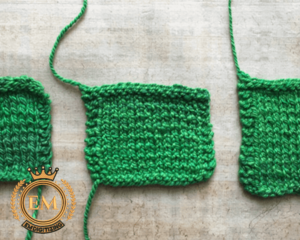
A double-running stitch is called a two-play stitch. This stitch is produced by the machine sewing a complete running stitch area and then coming back over the same area and stopping where it began.
Underlay is used under the regular stitching in a pattern. The stitches are placed to give stability to the fabric and to make different effects. It is a series of running stitches or an extremely light-density fill often placed in the opposite direction that the stitching would go.

Stitches are laid down before other design components to assist stabilize stretchy materials and to track down high naps on materials so the design’s details don’t get lost.
The ability to scale a design to different sizes is called variable sizing.
Sample sew-out or print out a new embroidery design to ensure the design is right
Here is the end of the embroidery digitizing glossary. We hope this embroidery digitizing a to z glossary would be helpful for you all.
We have made sure to cover everything for you all. Hope you have understood every term precisely. If you want to customize embroidery logo digitizing, EM DIGITIZING will be your best choice. At EM DIGITIZING, we deliver the best embroidery logo digitizing services with the best quality. We offer 50% off on all our services to our potential customers on their first order. So, get a free quote now and we will get in touch with you.
Hope this article will be helpful for you guys!
If there’s any question related to this article feel free to comment to us. And, thanks for reading!
Hope it will be helpful for you guys!
If there’s any question related to this article you can simply ask in the comment section and don’t forget to share with those you think might be helpful for them.
And finally, thanks for reading!
Modern embroidery machines cannot work with standard JPG, PNG, or other image files. Regardless, the graphic should be transformed into a format that the machine could turn into stitches. Quotes from embroidery shops would often tag the cost of this process as a setup cost or digitizing cost. It is a one-time cost and any repeat runs would be capable to utilize a similar digitized file. Digitizing is an intricate process that needs professional training and it is not something you could do with your basic graphic editing software. There are a lot of considerations when preparing an embroidery design, like determining how far apart the stitches must be, and the kinds of stitches that would be used.
Errors in digitizing come in five primary flavors – setting errors, using a tool in the wrong way, misplaced stitches, improper tools use, and sequence of programming.
The digitizing software converts the pictures and designs into stitching that a machine could understand easily. Understanding the embroidery digitizing types is one of the most important pieces of the maze. There are a lot of variables and choices to think about while assessing and choosing the types of embroidery digitizing. Digitizing is not as easy as uploading your picture file to the machine and setting it to function. It is a lot more intricate than that. Transforming the pictures digitally into embroidered designs is not a hundred percent automatic because the machines cannot identify and read the same files that your PC can. So, it has to be converted into a digitized design first because that is the language the embroidery machine understands.
Get embroidery digitizing cost estimation for free within few minutes.